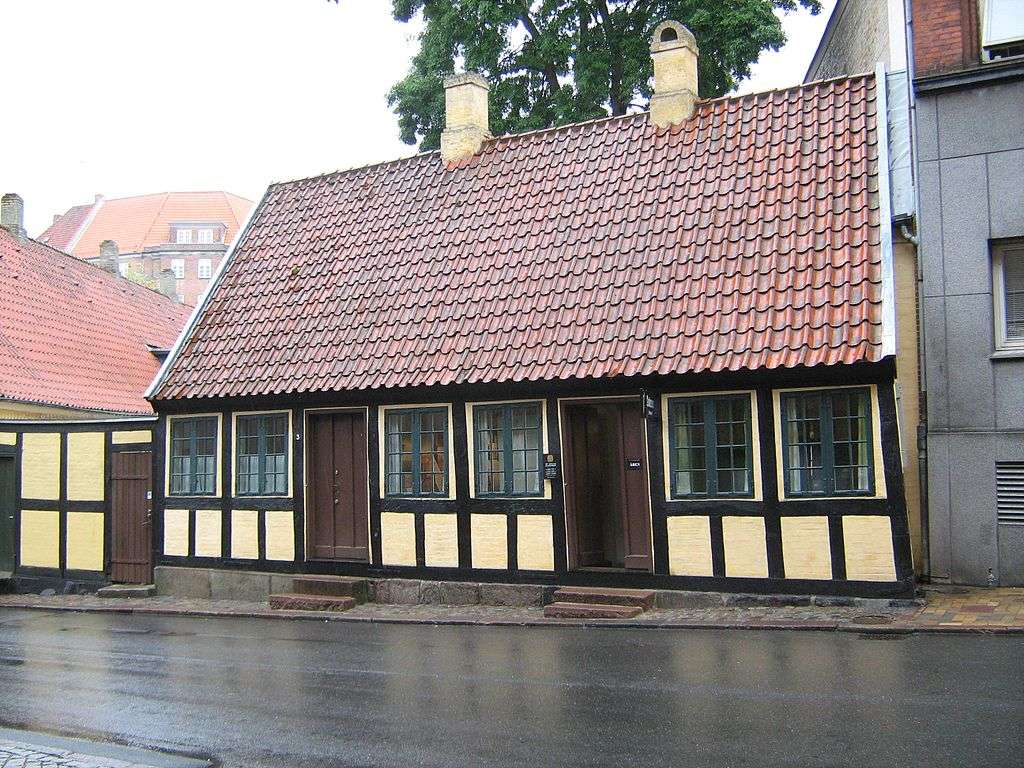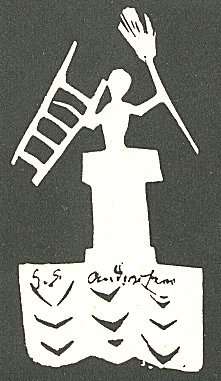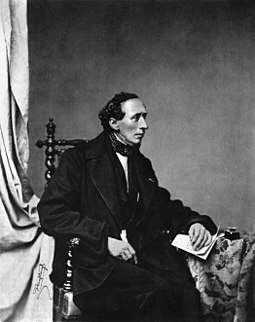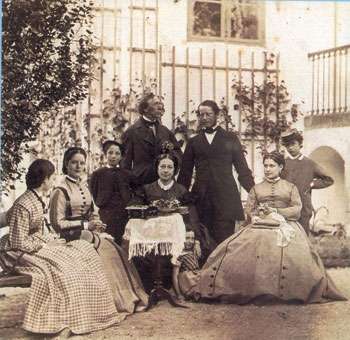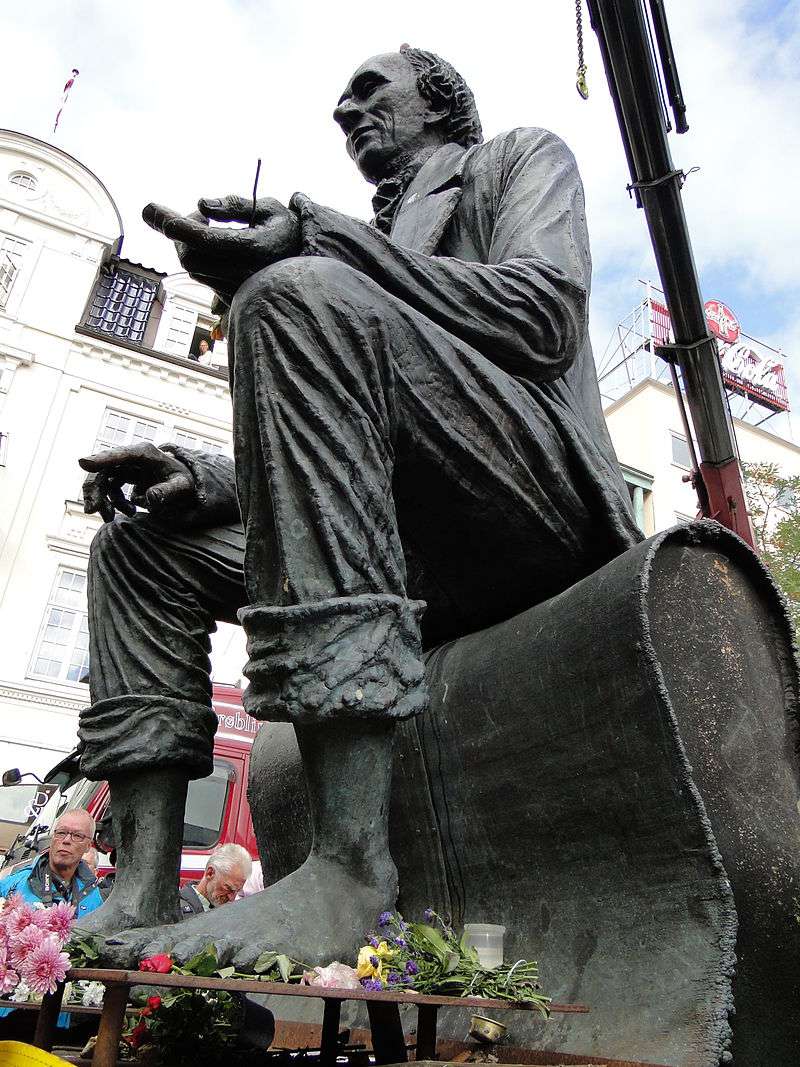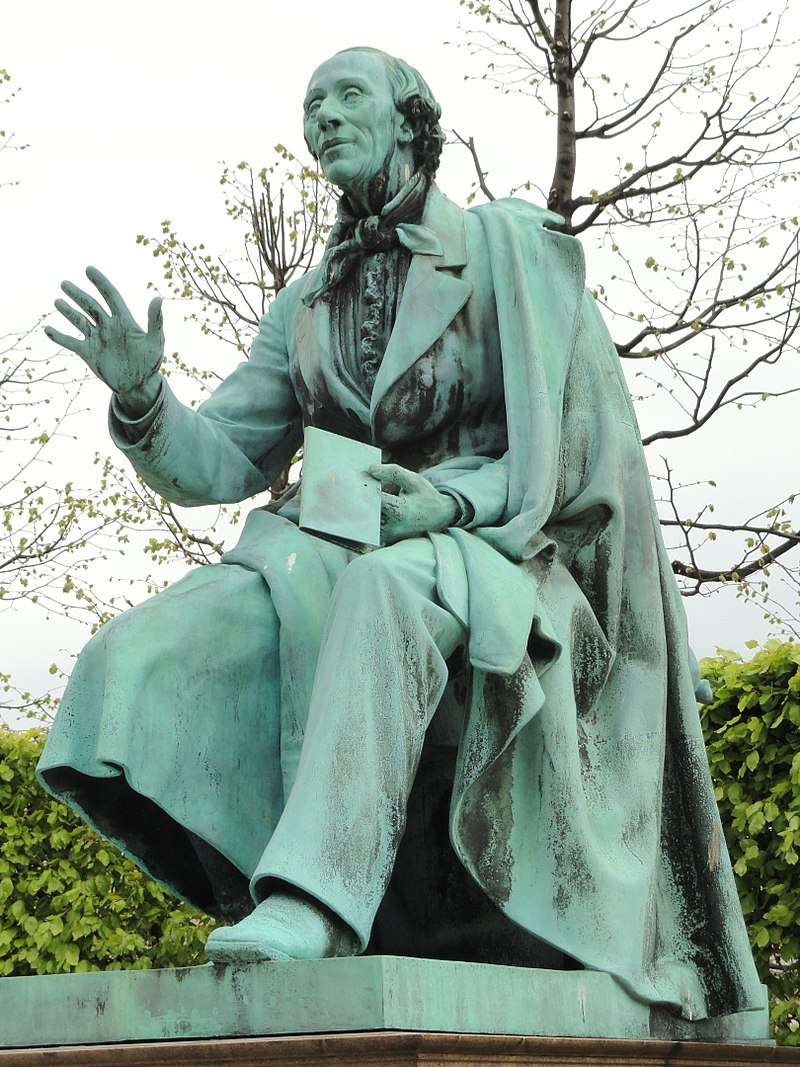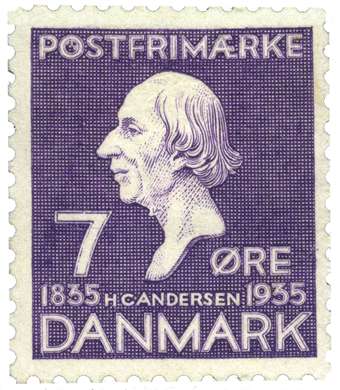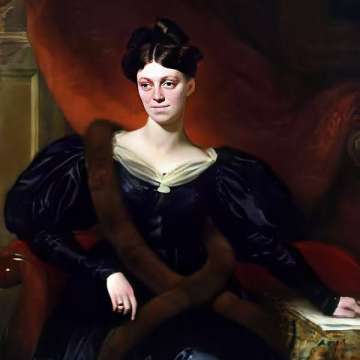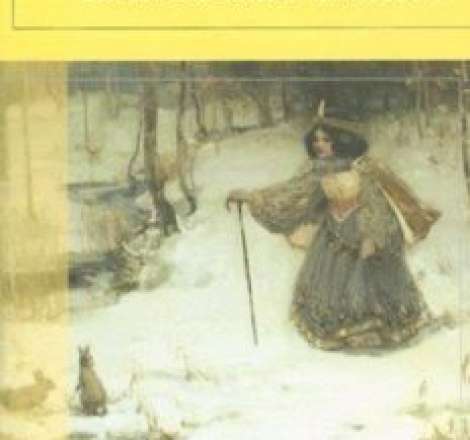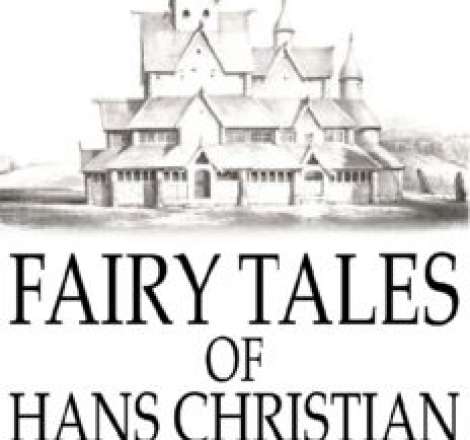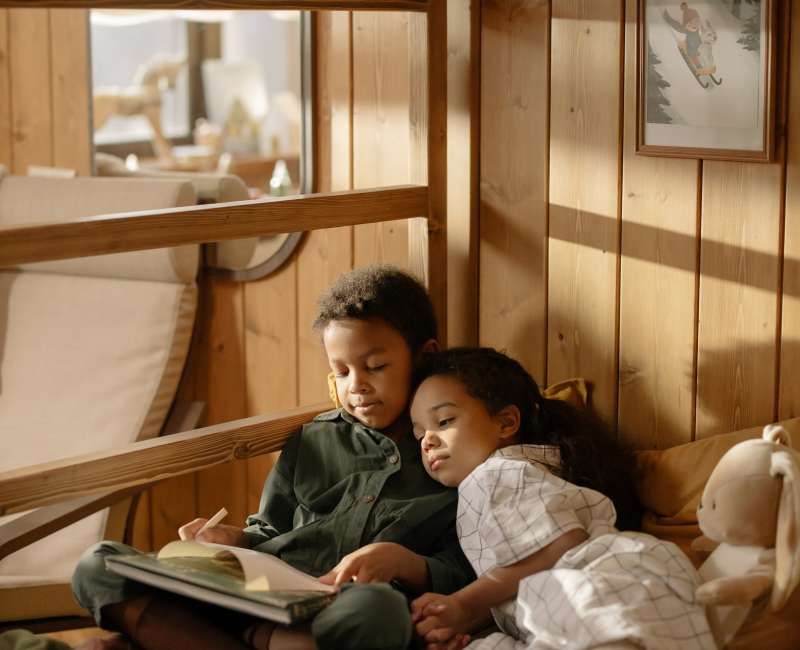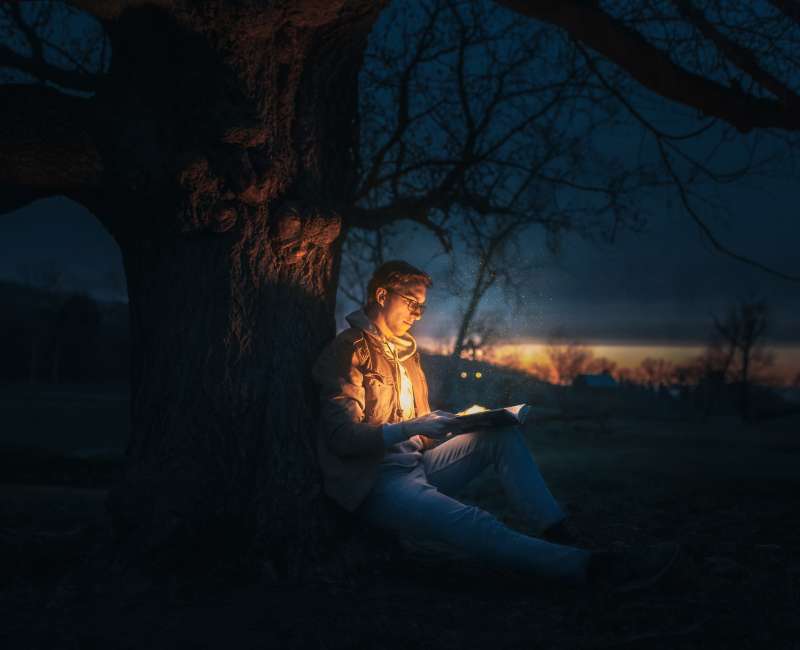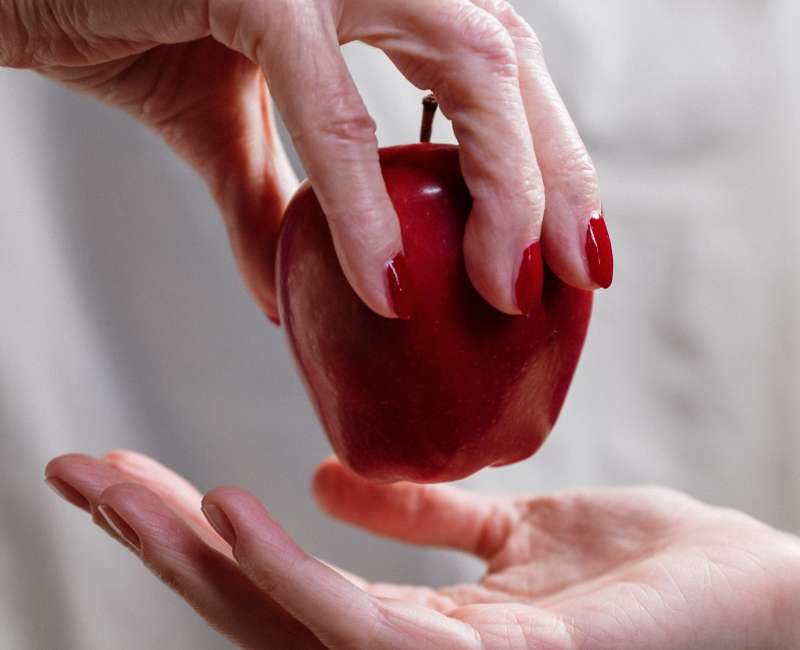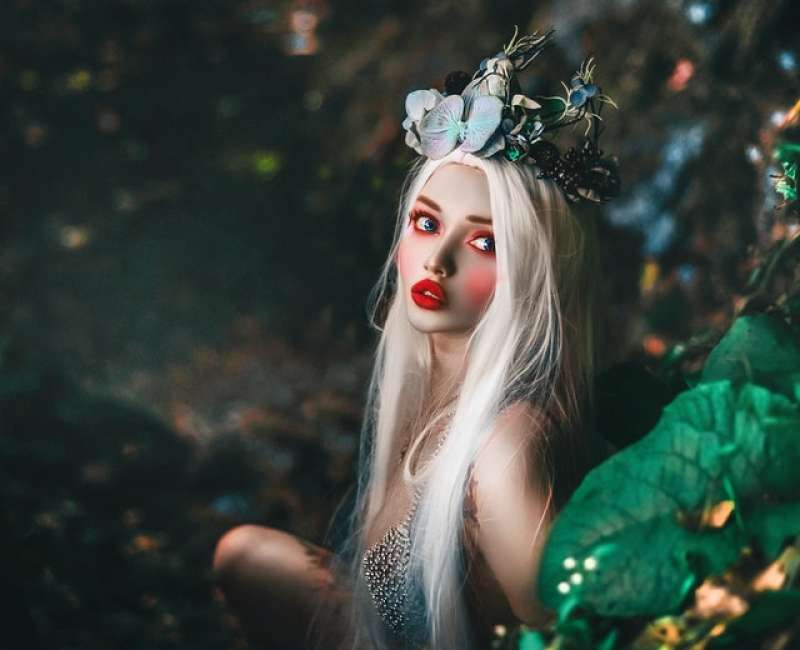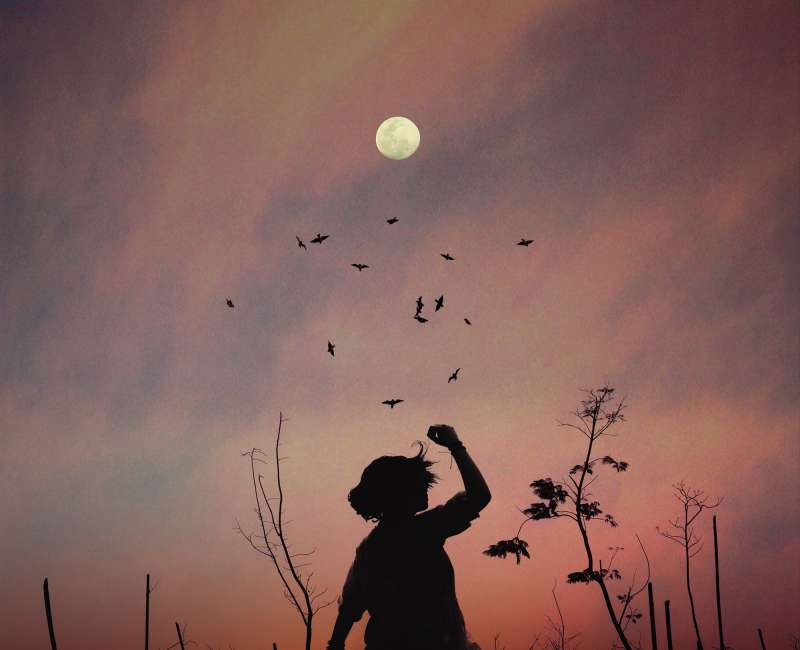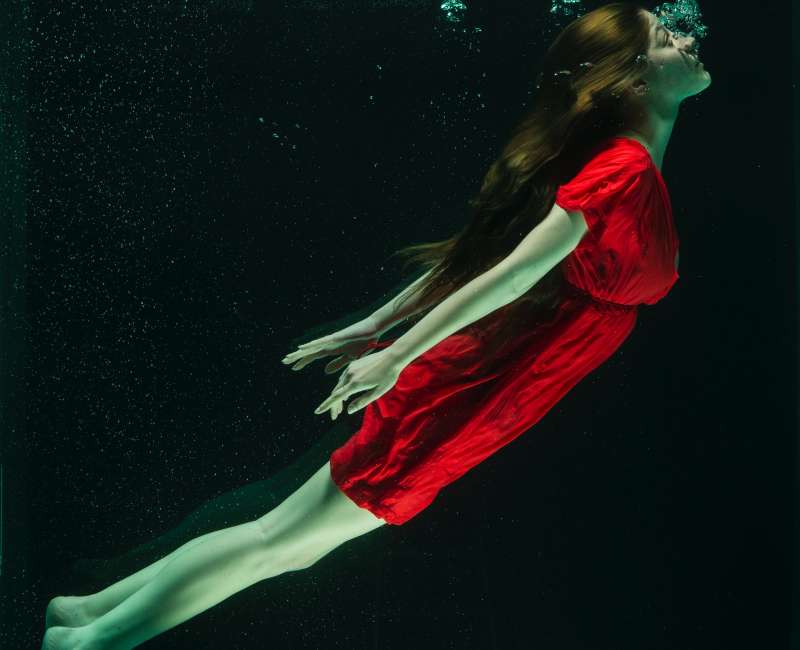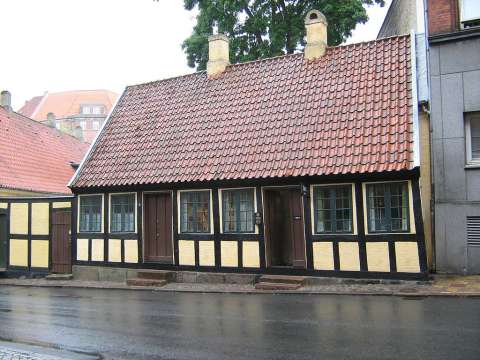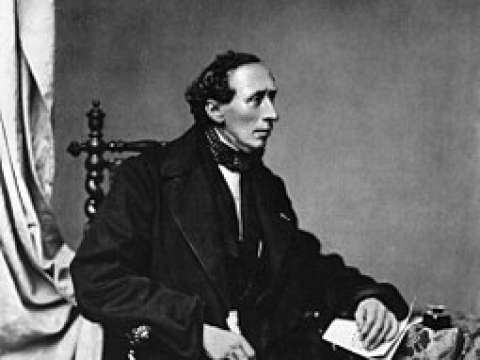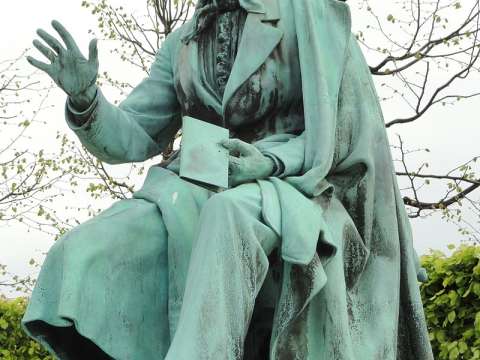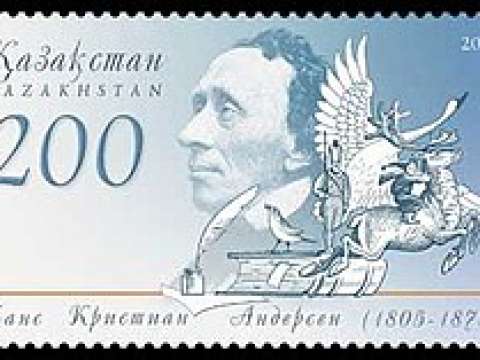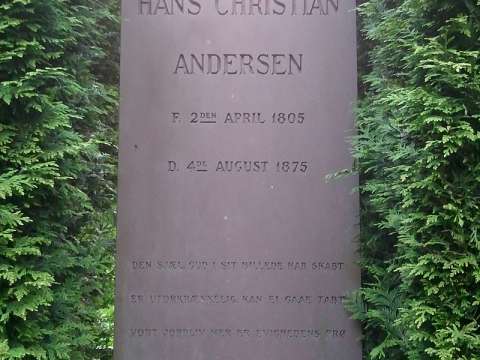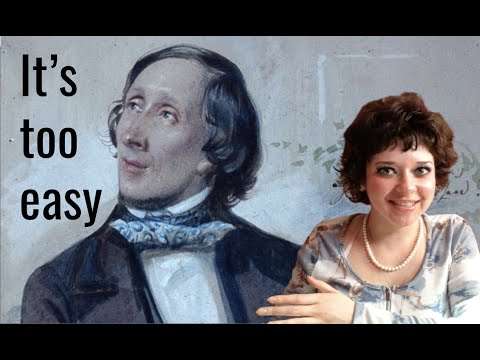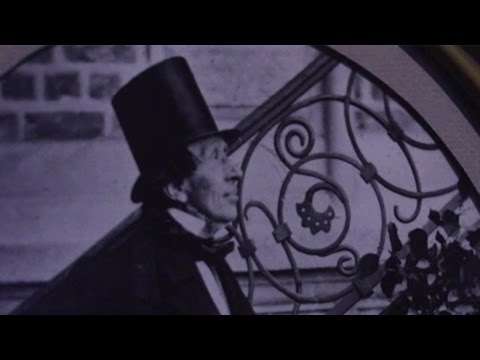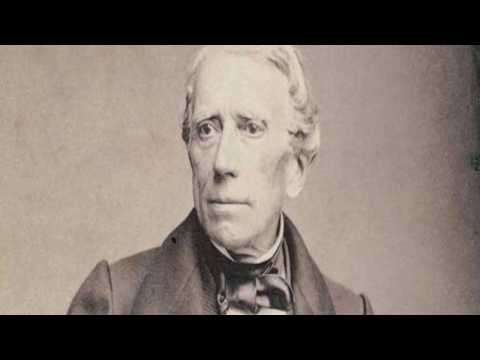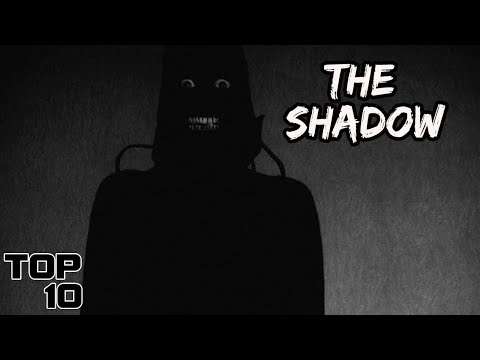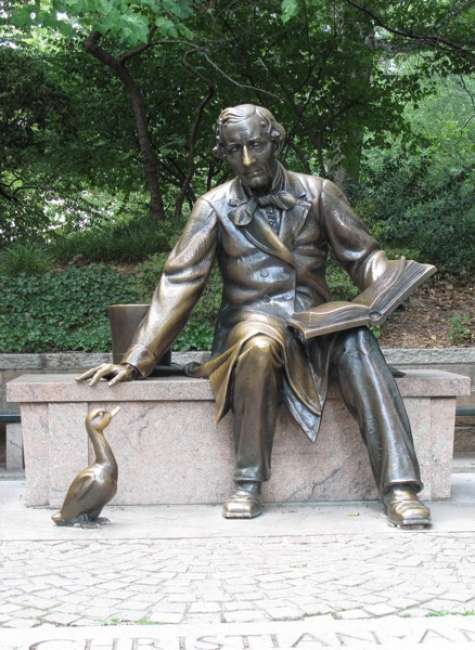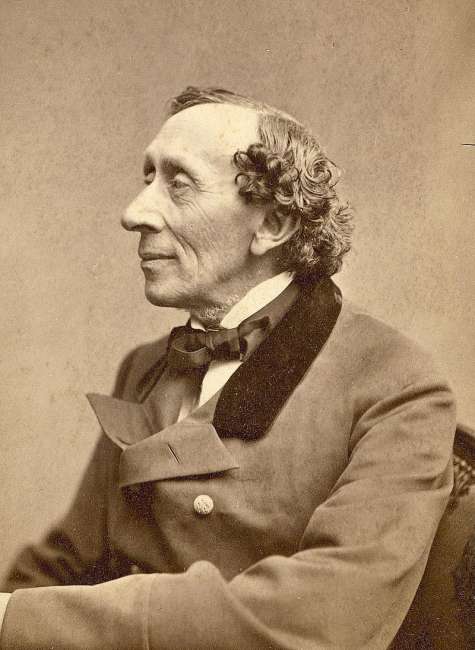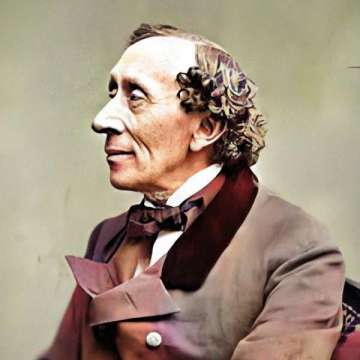

Hans Christian Andersen (1805-1875)

But a mermaid has no tears, and therefore she suffers so much more.
Hans Christian Andersen, in Denmark usually called H.C. Andersen, was a Danish author. Although a prolific writer of plays, travelogues, novels, and poems, he is best remembered for his fairy tales.
Andersen's fairy tales, consisting of 156 stories across nine volumes and translated into more than 125 languages, have become culturally embedded in the West's collective consciousness, readily accessible to children, but presenting lessons of virtue and resilience in the face of adversity for mature readers as well. His most famous fairy tales include "The Emperor's New Clothes," "The Little Mermaid," "The Nightingale," "The Steadfast Tin Soldier", "The Red Shoes", "The Princess and the Pea," "The Snow Queen," "The Ugly Duckling," "The Little Match Girl," and "Thumbelina." His stories have inspired ballets, plays, and animated and live-action films. One of Copenhagen's widest and busiest boulevards, skirting Copenhagen City Hall Square at the corner of which Andersen's larger-than-life bronze statue sits, is named "H. C. Andersens Boulevard."
Early life
"It doesn't matter about being born in a duckyard, as long as you are hatched from a swan's egg" "The Ugly Duckling"
Hans Christian Andersen was born in Odense, Denmark on 2 April 1805. He was an only child. His father, also named Hans, considered himself related to nobility his paternal grandmother had told his father that their family had belonged to a higher social class, but investigations have disproved these stories. A persistent speculation suggests that Andersen was an illegitimate son of King Christian VIII, but this notion has been challenged.
Hans Christian Andersen was baptised April 15, 1805 in Saint Hans Church St John's Church in Odense, Denmark. His certificate of birth was not drafted until November 1823, according to which six Godparents were present at the baptising ceremony: Madam Sille Marie Breineberg, Maiden Friederiche Pommer, Shuemaker Peder Waltersdorff, journeyman carpenter Anders Jørgensen, Hospital portner Nicolas Gomard, and Royal Hatter Jens Henrichsen Dorch.

Andersen's father, who had received an elementary school education, introduced his son to literature, reading to him the Arabian Nights. Andersen's mother, Anne Marie Andersdatter, was an illiterate washerwoman. Following her husband's death in 1816, she remarried in 1818. Andersen was sent to a local school for poor children where he received a basic education and had to support himself, working as an apprentice to a weaver and, later, to a tailor. At fourteen, he moved to Copenhagen to seek employment as an actor. Having an excellent soprano voice, he was accepted into the Royal Danish Theatre, but his voice soon changed. A colleague at the theatre told him that he considered Andersen a poet. Taking the suggestion seriously, Andersen began to focus on writing.
Jonas Collin, director of the Royal Danish Theatre, held great affection for Andersen and sent him to a grammar school in Slagelse, persuading King Frederick VI to pay part of the youth's education. Andersen had by then published his first story, "The Ghost at Palnatoke's Grave" 1822. Though not a stellar pupil, he also attended school at Elsinore until 1827.
He later said, that his years at this school were the darkest and most bitter years of his life. At one particular school, he lived at his schoolmaster's home. There, he was abused and he was told, that it was done in order "to improve his character". He later said that the faculty had discouraged him from writing, which then resulted in a depression.
Career
Early work
A very early fairy tale by Andersen, "The Tallow Candle" Danish: Tællelyset, was discovered in a Danish archive in October 2012. The story, written in the 1820s, is about a candle that did not feel appreciated. It was written while Andersen was still in school and dedicated to one of his benefactors. The story remained in that family's possession until it turned up among other family papers in a local archive.

In 1829, Andersen enjoyed considerable success with the short story "A Journey on Foot from Holmen's Canal to the East Point of Amager." Its protagonist meets characters ranging from Saint Peter to a talking cat. Andersen followed this success with a theatrical piece, Love on St. Nicholas Church Tower, and a short volume of poems. He made little progress in writing and publishing immediately following the issue of these poems but he did receive a small travel grant from the king in 1833. This enabled him to set out on the first of many journeys throughout Europe. At Jura, near Le Locle, Switzerland, Andersen wrote the story "Agnete and the Merman". The same year he spent an evening in the Italian seaside village of Sestri Levante, the place which inspired the title of "The Bay of Fables". He arrived in Rome in October 1834. Andersen's travels in Italy were reflected in his first novel, a fictionalized autobiography titled The Improvisatore Improvisatoren, published in 1835 to instant acclaim.
Fairy Tales
Fairy Tales Told for Children. First Collection. Danish: Eventyr, fortalt for Børn. Første Samling. is a collection of nine fairy tales by Hans Christian Andersen. The tales were published in a series of three installments by C. A. Reitzel in Copenhagen, Denmark between May 1835 and April 1837, and represent Andersen's first venture into the fairy tale genre.
The first installment of sixty-one unbound pages was published 8 May 1835 and contained "The Tinderbox", "Little Claus and Big Claus", "The Princess and the Pea" and "Little Ida's Flowers". The first three tales were based on folktales Andersen had heard in his childhood while the last tale was completely Andersen's creation and created for Ida Thiele, the daughter of Andersen's early benefactor, the folklorist Just Mathias Thiele. Reitzel paid Andersen thirty rixdollars for the manuscript, and the booklet was priced at twenty-four shillings.
The second booklet was published on 16 December 1835 and contained "Thumbelina", "The Naughty Boy" and "The Traveling Companion". "Thumbelina" was completely Andersen's creation although inspired by "Tom Thumb" and other stories of miniature people. "The Naughty Boy" was based on a poem by Anacreon about Cupid, and "The Traveling Companion" was a ghost story Andersen had experimented with in the year 1830.
The third booklet contained "The Little Mermaid" and "The Emperor's New Clothes", and it was published on the 7 April 1837. "The Little Mermaid" was completely Andersen's creation though influenced by De la Motte Fouqué's "Undine" 1811 and the lore about mermaids. This tale established Andersen's international reputation. The only other tale in the third booklet was "The Emperor's New Clothes", which was based on a medieval Spanish story with Arab and Jewish sources. On the eve of the third installment's publication, Andersen revised the finish of his story, the Emperor simply walks in procession to its now-familiar finale of a child calling out, "The Emperor is not wearing any clothes!"
Danish reviews of the first two booklets appeared in 1836 and they were not enthusiastic. The critics disliked the chatty, informal style, and immorality that flew in the face of their expectations. Children's literature was meant to educate rather than to amuse. The critics discouraged Andersen from pursuing this type of style. Andersen believed, that he was working against the critics' preconceived notions about fairy tales and he temporarily returned to novel-writing. The critic's reaction was so severe that Andersen waited a full year before publishing his third installment.
The nine tales of the three booklets were combined and then published in one volume and sold at seventy-two shillings. A title page, a table of contents, and a preface by Andersen were published in this volume.
Travelogues
In 1851, he published In Sweden, a volume of travel sketches. The publication received wide acclaims. A keen traveler, Andersen published several other long travelogues: Shadow Pictures of a Journey to the Harz, Swiss Saxony, etc. etc. in the Summer of 1831, A Poet's Bazaar, In Spain and A Visit to Portugal in 1866. The last describes his visit with his Portuguese friends Jorge and Jose O'Neill, who were his friends in the mid-1820s while he was living in Copenhagen. In his travelogues, Andersen took heed of some of the contemporary conventions related to travel writing but he always developed the style to suit his own purpose. Each of his travelogues combines documentary and descriptive accounts of his experiences, adding additional philosophical passages on topics such as what it is to be an author, general immortality, and the nature of fiction in literary travel reports. Some of the travelogues, such as In Sweden, even contain fairy-tales.
In the 1840s, Andersen's attention again returned to the theatre stage, but with little success. He had better luck with the publication of the Picture-Book without Pictures 1840. A second series of fairy tales was started in 1838 and a third series in 1845. Andersen was now celebrated throughout Europe although his native Denmark still showed some resistance to his pretensions.
Between 1845 and 1864, H. C. Andersen lived at Nyhavn 67, Copenhagen, where a memorial plaque is placed on a building.
Personal life
Kierkegaard
In ‘Andersen as a Novelist’, Kierkegaard remarks that Andersen is characterized as, “...a possibility of a personality, wrapped up in such a web of arbitrary moods and moving through an elegiac duo-decimal scale of almost echoless, dying tones just as easily roused as subdued, who, in order to become a personality, needs a strong life-development.”
Meetings with Dickens
In June 1847, Andersen paid his first visit to England and he enjoyed a triumphal social success during this summer. The Countess of Blessington invited him to her parties where intellectual people would meet, and it was at one of such parties where he met Charles Dickens for the first time. They shook hands and walked to the veranda, which Andersen wrote about in his diary: "We were on the veranda, and I was so happy to see and speak to England's now-living writer whom I do love the most."
The two authors respected each other's work and as writers, they shared something important in common: depictions of the poor and the underclass who often had difficult lives affected both by the Industrial Revolution and by abject poverty. In the Victorian era there was a growing sympathy for children and an idealization of the innocence of childhood.
Ten years later, Andersen visited England again, primarily to meet Dickens. He extended the planned brief visit to Dickens' home at Gads Hill Place into a five-week stay, much to the distress of Dickens' family. After Andersen was told to leave, Dickens gradually stopped all correspondence between them, this to the great disappointment and confusion of Andersen, who had quite enjoyed the visit and could never understand why his letters went unanswered.
Love life
In Andersen's early life, his private journal records his refusal to have sexual relations.
Andersen often fell in love with unattainable women, and many of his stories are interpreted as references. At one point, he wrote in his diary: "Almighty God, thee only have I; thou steerest my fate, I must give myself up to thee! Give me a livelihood! Give me a bride! My blood wants love, as my heart does!" A girl named Riborg Voigt was the unrequited love of Andersen's youth. A small pouch containing a long letter from Voigt was found on Andersen's chest when he died several decades after he first fell in love with her, and after, he presumably fell in love with others. Other disappointments in love included Sophie Ørsted, the daughter of the physicist Hans Christian Ørsted, and Louise Collin, the youngest daughter of his benefactor Jonas Collin. One of his stories, "The Nightingale", was written as an expression of his passion for Jenny Lind and became the inspiration for her nickname, the "Swedish Nightingale". Andersen was often shy around women and had extreme difficulty in proposing to Lind. When Lind was boarding a train to go to an opera concert, Andersen gave Lind a letter of proposal. Her feelings towards him were not the same; she saw him as a brother, writing to him in 1844: "farewell ... God bless and protect my brother is the sincere wish of his affectionate sister, Jenny".

Andersen certainly experienced same-sex attraction as well: he wrote to Edvard Collin: "I languish for you as for a pretty Calabrian wench ... my sentiments for you are those of a woman. The femininity of my nature and our friendship must remain a mystery." Collin, who preferred women, wrote in his own memoir: "I found myself unable to respond to this love, and this caused the author much suffering." Likewise, the infatuations of the author for the Danish dancer Harald Scharff and Carl Alexander, the young hereditary duke of Saxe-Weimar-Eisenach, did not result in any relationships.
According to Anne Klara Bom and Anya Aarenstrup from the H. C. Andersen Centre of University of Southern Denmark, "To conclude, it is correct to point to the very ambivalent and also very traumatic elements in Andersen's emotional life concerning the sexual sphere, but it is decidedly just as wrong to describe him as homosexual and maintain that he had physical relationships with men. He did not. Indeed, that would have been entirely contrary to his moral and religious ideas, aspects that are quite outside the field of vision of Wullschlager and her like."
Death
In early 1872, at age 67, Andersen fell out of his bed and was severely hurt; he never fully recovered from the resultant injuries. Soon afterward, he started to show signs of liver cancer.
He died on 4 August 1875, in a house called Rolighed literally: calmness, near Copenhagen, the home of his close friends, the banker Moritz Melchior and his wife. Shortly before his death, Andersen had consulted a composer about the music for his funeral, saying: "Most of the people who will walk after me will be children, so make the beat keep time with little steps."

His body was interred in the Assistens Kirkegård in the Nørrebro area of Copenhagen, in the family plot of the Collins. However, in 1914 the stone was moved to another cemetery today known as "Frederiksbergs ældre kirkegaard", where younger Collin family members were buried. For a period, his, Edvard Collin's and Henriette Collin's graves were unmarked. A second stone has been erected, marking H.C. Andersen's grave, now without any mention of the Collin couple, but all three still share the same plot.
At the time of his death, Andersen was internationally revered, and the Danish Government paid him an annual stipend as a "national treasure".
Legacy and cultural influence
Archives, collections and museums
- The Hans Christian Andersen Museum or H.C. Andersens Odense, is a set of museums/buildings dedicated to the famous author Hans Christian Andersen in Odense, Denmark, some of which, at various times in history, have functioned as the main Odense-based museum on the author.
- The Hans Christian Andersen Museum in Solvang, California, a city founded by Danes, is devoted to presenting the author's life and works. Displays include models of Andersen's childhood home and of "The Princess and the Pea". The museum also contains hundreds of volumes of Andersen's works, including many illustrated first editions and correspondence with Danish composer Asger Hamerik.
- The Library of Congress Rare Book and Special Collections Division was bequeathed an extensive collection of Andersen materials by the Danish-American actor Jean Hersholt. Of particular note is an original scrapbook Andersen prepared for the young Jonas Drewsen.
Art, entertainment and media
Audio recordings
Noteworthy recordings in English include:
- Tales of Hans Christian Andersen Caedmon Records TC-1073, 1958, read by Michael Redgrave
- The Snow Queen Caedmon Records TC-1229, 1958, read by Cathleen Nesbitt
- Tales of Hans Christian Andersen Caedmon Records TC-1109, 1959, read by Boris Karloff; Karloff also narrated Hans Christian Andersen: The Little Match Girl and Other Fairy Tales Caedmon Records TC-1117, 1960
- Hans Christian Andersen's Fairy Tales Golden Records LP-74, 1962, read by Danny Kaye; re-issued on CD in 2008 as part of Danny Kaye Re-Tells Grimm's and Hans Christian Andersen's Fairy Tales Golden Records 826663-11082
- Victor Borge presents His Own Enchanting Version of Hans Christian Andersen Decca Records DL7-34406, 1966
- The Little Mermaid Caedmon Records TC-1230, 1967, read by Cathleen Nesbitt
- Hans Christian Andersen: His Poems and the Story of His Life Caedmon Records TC-1366, 1972, read by Siobhan McKenna
- Hans Christian Andersen's Fairy Stories Pye Records PKL-5520, 1978, performed by Dame Edith Evans and Sir John Betjeman
- The Steadfast Tin Soldier Windham Hill Records WH-0702, 1987, read by Jeremy Irons
- The Emperor and the Nightingale Windham Hill Records WH-0706, 1987, read by Glenn Close
- The Ugly Duckling Windham Hill Records WH-0705, 1987, read by Cher
- The Emperor's New Clothes Windham Hill Records WH-0719, 1990, read by John Gielgud
- The Snow Queen Delos DE-6004, 1991, read by Natalia Makarova
- The Snow Queen Lightyear 75108-2, 1991, read by Sigourney Weaver
- The Emperor's New Clothes: An All-Star Retelling of the Classic Fairy Tale Starbright Foundation, 1998 NOTE: this was an audio CD included with the printed book; the cast included Liam Neeson, John Lithgow, Melissa Mathison, Harrison Ford, Nathan Lane, Dr. Ruth Westheimer, Robin Williams, Carrie Fisher, Penny Marshall, Jonathan Taylor Thomas, Melissa Joan Hart, Jay Leno, Jason Alexander, Rosie O'Donnell, Calvin Klein, Dan Aykroyd, Steven Spielberg, Jeff Goldblum, Joan Rivers, Madonna, Fran Drescher, Angela Lansbury and General Norman Schwarzkopf.
Tale Spinners for Children released seven LP's of dramatizations of Andersen stories:
- "The Ugly Duckling" UAC 11008
- "The Tinder Box" which was included with "The Pied Piper" UAC 11017
- "The Emperor's New Clothes" which was included with "Hop O' My Thumb" UAC 11021
- "Thumbelina" UAC 11038
- "The Little Mermaid" UAC 11042
- "The Snow Queen" UAC 11061
- "The Red Shoes" UAC 11063
Films
- La petite marchande d'allumettes 1928; in English: The Little Match Girl, film by Jean Renoir based on "The Little Match Girl"
- The Ugly Duckling 1931, an animated short film produced by Walt Disney Feature Animation, based on The Ugly Duckling.
- Andersen was played by Joachim Gottschalk in the German film The Swedish Nightingale 1941, which portrays his relationship with the singer Jenny Lind.
- The Red Shoes 1948 British drama film written, directed, and produced by the team of Michael Powell and Emeric Pressburger based on "The Red Shoes".
- Hans Christian Andersen 1952, an American musical film starring Danny Kaye that, though inspired by Andersen's life and literary legacy, was meant to be neither historically nor biographically accurate; it begins by saying, "This is not the story of his life, but a fairy tale about this great spinner of fairy tales"
- The Snow Queen 1957, a Soviet Union Russian animated film by Lev Atmanov of Soyuzmultfilm, is considered the first cinematic adaptation of The Snow Queen, and is noted for its authentic depiction of the fairy tale that has crossed political/geographical walls and boundaries to critical acclaim
- Carevo novo ruho The emperor's new clothes, a 1961 Croatian film, directed by Ante Babaja.
- The Rankin/Bass Productions-produced fantasy film, The Daydreamer 1966, depicts the young Hans Christian Andersen imaginatively conceiving the stories he would later write.
- The World of Hans Christian Andersen 1968, a Japanese anime fantasy film from Toei Doga, based on the works of Danish author Hans Christian Andersen
- The Little Mermaid 1989, an animated film based on The Little Mermaid created and produced at Walt Disney Feature Animation in Burbank, CA
- Thumbelina 1994, an animated film based on the "Thumbelina" created and produced at Sullivan Bluth Studios Dublin, Ireland
- The Little Matchgirl 2006, an animated short film by the Walt Disney Animation Studios directed by Roger Allers and produced by Don Hahn
- Hans Christian Andersen: My Life as a Fairy Tale 2003, a British made-for-television film directed by Philip Saville , a fictionalized account of Andersen's early successes, with his fairy stories intertwined with events in his own life.
- One segment in Fantasia 2000 is based on The Steadfast Tin Soldier, against Shostakovich's Piano Concerto No. 2, Movement #1: "Allegro".
- The Snow Queen 2012, a Russian 3D animated film series produced by Wizart Animation is considered a tribute to the Soviet Union classic as well as the fairy tale that has won critical acclaim for its authenticity as well as being a foundation for a tetralogy series
- Frozen 2013, a 3D computer-animated film produced by Walt Disney Animation Studios, was initially intended to be based on The Snow Queen, though numerous changes were made until the end result bore almost no resemblance to the original story.
- Ginger's Tale 2020, a Russian frame-by-frame 2D traditional animated film loosely based on The Tinderbox created and produced at Vverh Animation Studio in Moscow
Literature
Andersen's stories laid the groundwork for other children's classics, such as The Wind in the Willows 1908 by Kenneth Grahame and Winnie-the-Pooh 1926 by A. A. Milne. The technique of making inanimate objects, such as toys, come to life "Little Ida's Flowers" would later also be used by Lewis Carroll and Beatrix Potter.
- "Match Girl", a short story by Anne Bishop published in Ruby Slippers, Golden Tears
- "The Chrysanthemum Robe", a short story by Kara Dalkey based on "The Emperor's New Clothes" and published in The Armless Maiden
- The Nightingale by Kara Dalkey, lyrical adult fantasy novel set in the courts of old Japan
- The Girl Who Trod on a Loaf by Kathryn Davis, a contemporary novel about fairy tales and opera
- "Sparks", a short story by Gregory Frost based on "The Tinder Box", published in Black Swan, White Raven
- "The Pangs of Love", a short story by Jane Gardam based on "The Little Mermaid", published in Close Company: Stories of Mothers and Daughters
- "The Last Poems About the Snow Queen", a poem cycle by Sandra Gilbert published in Blood Pressure.
- The Snow Queen by Eileen Kernaghan, a gentle Young Adult fantasy novel that brings out the tale's subtle pagan and shamanic elements
- The Wild Swans by Peg Kerr, a novel that brings Andersen's fairy tale to colonial and modern America
- "Steadfast", a short story by Nancy Kress based on "The Steadfast Tin Soldier", published in Black Swan, White Raven
- "In the Witch's Garden" October 2002, a short story by Naomi Kritzer based on "The Snow Queen", published in Realms of Fantasy magazine
- Daughter of the Forest by Juliet Marillier, a romantic fantasy novel, set in early Medieval Ireland thematically linked to "The Six Swans"
- "The Snow Queen", a short story by Patricia A. McKillip published in Snow White, Blood Red
- "You, Little Match Girl", a short story by Joyce Carol Oates published in Black Heart, Ivory Bones
- "The Real Princess", a short story by Susan Palwick based on "The Princess and the Pea", published in Ruby Slippers, Golden Tears
- "The Naked King" "Голый Король Goliy Korol" 1937, "The Shadow" "Тень Ten" 1940, and "The Snow Queen" "Снежная Королева Sniezhenaya Koroleva" 1948 by Eugene Schwartz, reworked and adapted to the contemporary reality plays by one of Russia's playwrights. Schwartz's versions of The Shadow and The Snow Queen were later made into movies 1971 and 1967, respectively.
- "The Sea Hag", a short story by Melissa Lee Shaw based on "The Little Mermaid", published in Silver Birch, Blood Moon
- The Snow Queen by Joan D. Vinge, an award-winning novel that reworks "The Snow Queen"'s themes into epic science fiction
- "The Steadfast Tin Soldier", a short story by Joan D. Vinge published in Women of Wonder
- "Swim Thru Fire", a comic by Sophia Foster-Dimino and Annie Mok, based partially on "The Little Mermaid".
Mobile app
- GivingTales – the storytelling app for children was created in aid of UNICEF in 2015. Hans Christian Andersen's fairy tales are read by Roger Moore, Stephen Fry, Ewan McGregor, Joan Collins and Joanna Lumley.
Monuments and sculptures
Statue in Central Park, New York commemorating Andersen and The Ugly Duckling Andersen statue at the Rosenborg Castle Gardens, Copenhagen Statue in Odense being led out to the harbour during a public exhibition Odense statue half-submerged in the water Statue in Solvang, California, a city built by Danish immigrants. Statue in Bratislava, Slovakia Portrait bust in Sydney unveiled by the Crown Prince and Princess of Denmark in 2005
- Hans Christian Andersen 1880, even before his death, steps had already been taken to erect, in Andersen's honour, a large statue by sculptor August Saabye, which can now be seen in the Rosenborg Castle Gardens in Copenhagen.
- Hans Christian Andersen 1896 by the Danish sculptor Johannes Gelert, at Lincoln Park in Chicago, on Stockton Drive near Webster Avenue
- Hans Christian Andersen 1956, a statue by sculptor Georg J. Lober and designer Otto Frederick Langman, at Central Park Lake in New York City, opposite East 74th Street 40.7744306°N, 73.9677972°W
- Hans Christian Andersen 2005 Plaza de la Marina in Malaga, Spain
Music
- Hans Christian Andersen album, a 1994 album by Franciscus Henri
- The Song is a Fairytale Sangen er et Eventyr, a song cycle based on fairy tales by Hans Christian Andersen, composed by Frederik Magle
- Atonal Fairy Tale, From the album It Is What It Isn't, Too!, 2020 by Smart Dad Living, music composed by Gregory Reid Davis Jr. and the fairy tale, The Elfin Mound, by Hans Christian Andersen is read by Smart Dad Living
Radio
- The Wild Swans BBC Radio 4, 1980, an adaptation of Andersen's story by John Peacock directed by Jane Morgan, with Angela Pleasence.
- The Snow Queen BBC Radio 4, 1994, an adaptation of Andersen's story by Bertie Doherty, directed by Janet Whitaker and featuring Diana Rigg in the title role and Dirk Bogarde as the Narrator.
- Hans Christian Andersen BBC Radio 4, 2005, a two-part radio play by Hattie Naylor dramatizing Andersen's life.
- The Beautiful Ugly BBC Radio 4, 2012, a radio play by Lavinia Murray directed by Pauline Harris, imagining a day in the life of Andersen as a child, combining fact with fantasy.
- The Red Shoes BBC Radio 4, 2017, an adaptation of Andersen's story by Frances Byrnes and directed by Eoin O'Callaghan.
- Dance 'Til You Bleed: The World According to Hans Christian Andersen BBC Radio 3, 2019: a dramatization by Lucy Catherine of five Andersen stories directed by Gemma Jenkins. Each story was introduced by author Joanne Harris and starred Toby Jones as Andersen, who also acted as narrator.
Stage productions
For opera and ballet see also List of The Little Mermaid Adaptations
- Little Hans Andersen 1903, a children's pantomime at the Adelphi Theatre
- Sam the Lovesick Snowman at the Center for Puppetry Arts: a contemporary puppet show by Jon Ludwig inspired by The Snow Man.
- Striking Twelve, a modern musical take on "The Little Match Girl", created and performed by GrooveLily.
- The musical comedy Once Upon a Mattress is based on Andersen' work 'The Princess and the Pea'.
Television
- The Snow Queen 1955, a British TV mini-series starring April Olrich
- The Emperor's New Clothes 1967 starring The Prince Street Players
- Andersen Monogatari 1971, an animated anthology of Andersen's works
- The Little Match Girl 1974 starring Lynsey Baxter
- Shelley Duvall's Faerie Tale Theatre 1982–87, an live-action anthology series which originally aired on Showtime; stories by Andersen which were dramatized included "The Nightingale", "The Little Mermaid", "The Princess and the Pea", "Thumbelina", "The Emperor's New Clothes" and "The Snow Queen".
- Hans Christian Andersen: My Life as a Fairytale 2003, a semi-biographical television miniseries that fictionalizes the young life of Danish author Hans Christian Andersen and includes fairy tales as short interludes, intertwined into the events of the young author's life.
- The Little Match Girl 1986 starring Michael Hordern, Twiggy, Roger Daltrey and Natalie Morse as The Match Girl
- The Little Match Girl 1990, an animated film starring F. Murray Abraham
- In the "Metal Fish" episode of the Disney TV series The Little Mermaid, Andersen is a vital character whose inspiration for writing his tale is shown to have been granted by an encounter with the show's protagonists.
- Snow Queen 2002 starring Bridget Fonda
- The Fairytaler 2004, a Danish animated television series based on the fairy tales of Hans Christian Andersen.
- Young Andersen 2005, a biographical television miniseries that tells of the formative boarding school years of the fairy tale writer.
Webseries
- Classic Alice 2014, a YouTube webseries, had a five-episode arc based on "The Butterfly"
Video Games
- Andersen appears in the mobile game Fate/Grand Order as a Caster class servant. In the London chapter, set in 1888, he is summoned by the Demonic Fog surrounding London. He allies himself with the player in order to find more information about the Holy Grail War.
- Andersen appears in Fate/Extra CCC as Caster, Kiara's servant.
Awards
- Hans Christian Andersen Awards, prizes awarded annually by the International Board on Books for Young People to an author and illustrator whose complete works have made lasting contributions to children's literature.
- Hans Christian Andersen Literature Award, a Danish literary award established in 2010
- Anderson's fable "The Emperor's New Clothes" was inducted in 2000 into the Prometheus Hall of Fame for Best Classic Fiction
Events and holidays
- Andersen's birthday, 2 April, is celebrated as International Children's Book Day.
- The year 2005, designated "Andersen Year" in Denmark, was the bicentenary of Andersen's birth, and his life and work was celebrated around the world.
- In Denmark, a well-attended "once in a lifetime" show was staged in Copenhagen's Parken Stadium during "Andersen Year" to celebrate the writer and his stories.
- The annual H.C. Andersen Marathon, established in 2000, is held in Odense, Denmark
Places named after Andersen
- H. C. Andersens Boulevard, a major road in Copenhagen formerly known as Vestre Boulevard Western Boulevard, received its current name in 1955 to mark the 150-year anoversary of the writer's birth
- Hans Christian Andersen Airport, small airport servicing the Danish city of Odense
- Instituto Hans Christian Andersen, Chilean high school located in San Fernando, Colchagua Province, Chile
- Hans Christian Andersen Park, Solvang, California
- CEIP Hans Christian Andersen, Primary Education School in Malaga, Spain.
Postage stamps
- Andersen's legacy includes the postage stamps of Denmark and of Kazakhstan depicted above, depicting Andersen's profile.
Theme parks
- In Japan, the city of Funabashi has a children's theme park named after Andersen. Funabashi is a sister city to Odense, the city of Andersen's birth.
- In China, a US$32 million theme park based on Andersen's tales and life was expected to open in Shanghai's Yangpu District in 2017. Construction on the project began in 2005.
Cultural references
In Gilbert and Sullivan's Savoy Opera Iolanthe, the Lord Chancellor mocks the Fairy Queen with a reference to Andersen, thereby implying that her claims are fictional:
In Stephen Sondheim's A Little Night Music, the middle-aged Frederik contemplates reading erotic literature to his young, virginal bride in order to seduce her, but concludes: "Her taste is much blander / I'm sorry to say / But is Hans Christian Ander- / Sen ever risqué?"
Language
Titles like "The Ugly Duckling" and "The Emperor's New Clothes" have become idiomatic in several languages.
More facts
"The Ugly Duckling"
"The Emperor's New Clothes"
"The Little Match Girl"

